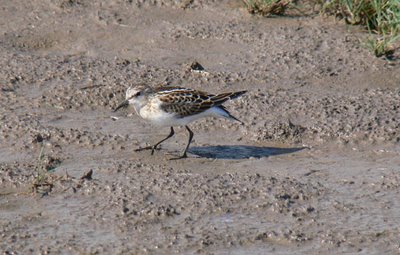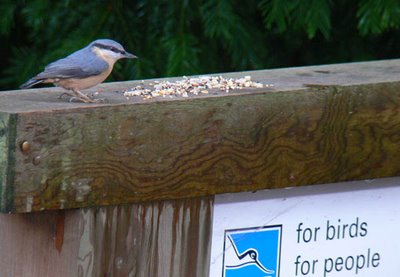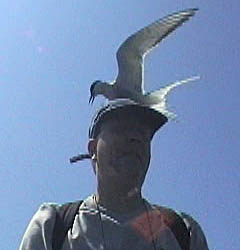"Did you see it?" .............. Heading back to the car, tripod and scope slung over my shoulder I was obviously a birdwatcher. Equally obvious from my blank look was the fact that I hadn't seen 'it' - unless 'it' was the ruff, which seemed a bit unlikely.
Ruff
The sandpiper, he said, before hurrying on down the track, explaining over his shoulder that he'd had a mobile phone call from 'Paul'. Few minutes dithering and I turned to follow. 'It' turned out to be a pectoral sandpiper, albeit a shy one! Worth seeing as a first for me, although no good for photos - not even the so-called record shot.
It's there - honestly!!
See what I mean?
That said I did get really good view of this Little Stint when walking back to the car again, so it was worth it. (Another example - I was standing watching the LS and a breathless new arrival appeared to say "where's the pec sand?". He then asked if I'd found the Stint - which was 10 feet in front of him! Mind you, I suppose they are small)
That said I did get really good view of this Little Stint when walking back to the car again, so it was worth it. (Another example - I was standing watching the LS and a breathless new arrival appeared to say "where's the pec sand?". He then asked if I'd found the Stint - which was 10 feet in front of him! Mind you, I suppose they are small)
Little Stint
Got me thinking about the way birdwatching is done these days. Guys peering at pagers, mobile phones, websites - a million miles removed from the old phone up that evening on a landline approach. Now within minutes of a rarity being spotted twitchers are on their way from all over the country. Just have a look at the surfbirds website 'stop press' galleries, where half a dozen different shots of the same bird taken by different people can appear in a day or two - a classic example being the admittedly beautiful pallid harrier in Norfolk at present. Or there was the sadly demised rose-coloured starling which was widely reported to have been harassed to death by the excited hordes in Norfolk. Following extract from Surfbirds news feed:
"...................... The reason the bird died was because of the two ticks draining its life blood and nothing to do whatsoever with birders scrambling to see it. Such parasites have had similar affects to a wide range of bird species throughout the ages. It was however feeding well and was taking Cranefly after Cranefly from the protected lawn inside the Wireless Station compound in Winterton village. It was ridiculously lethargic and struggling to fly far but fed to within a few feet of observers. Birders surrounded it but certainly did not hound it in any way nor was it 'chased' from pillar to post as suggested in the newspaper articles. Due to a Pallid Harrier in the vicinity, it was obviously visited by perhaps over 500 different observers over the weekend but as far as I know, it was certainly not 'hounded to death'. Hmmm - I don't suppose the 500 was a helpful situation really?.
Don't get me wrong. I'm happy to travel around my local patch if there's something to see. I use local birding websites, leading to views of black necked footy arses (read the archive!), hen harrier, snow bunting, purple sandpiper and most recently barn owls, that I probably would have missed otherwise. (Interestingly I have no photos of any, although some video of the grebes, bunting and harrier). I just can't really get the twitching, race-around-the-country thing - although that pallid harrier could tempt me!
That's another thing - I think if I did at all, I would only twitch the good looking things! The much photographed short toed lark on Great Orme may be rare, but it is a bit like many female finchy things, and not massively photogenic. Maybe that's it - I like some sort of picture more than the chase or the tick. And judging by the number of birding websites and blogs I'm not the only one - although some are truly photographers not snappers!
The old fashioned ways of finding birds still work though. Bemoaning the difficulty of getting a nuthatch to pose in the woods I was told to go to Symonds Yat and put some seeds on the RSPB sign - hey presto, some lovely misty views of the river valley, buzzards and then - the nuthatch.
Symonds Yat
Common Buzzard
Nuthatch
I wouldn't be without the websites though - the views of the barn owls over three evenings have been worth it alone - just a shame they wait until the light levels are so low before they come out, so the camera is useless. I've tried in the morning, but no birds. Still at least the biggest crowd we've had was 5, so hopefully they'll not go the way of the starling.


















No comments:
Post a Comment